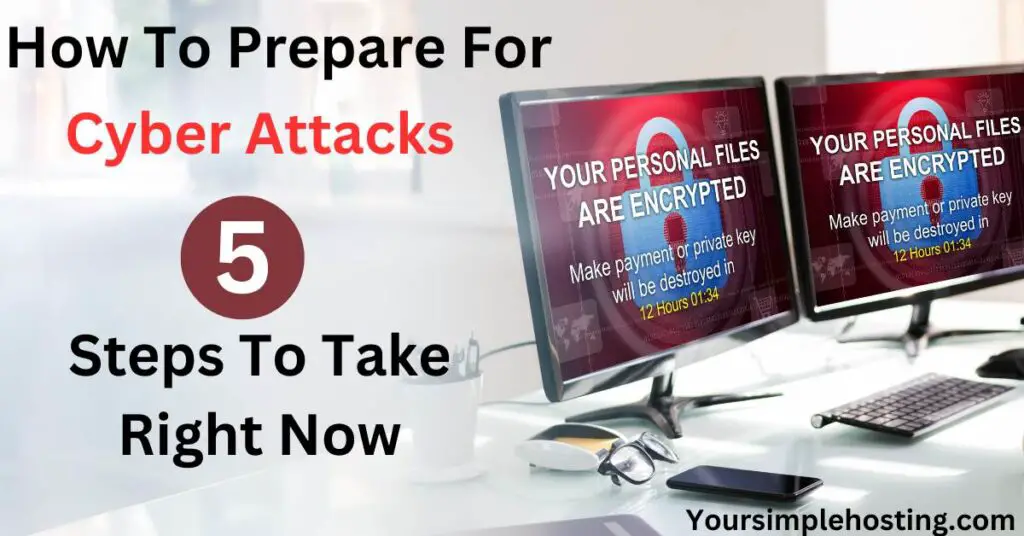In today’s fast-paced digital world, being vigilant about protecting our online presence is more important than ever. Unfortunately, cyber attacks can come in many forms, from phishing scams to ransomware attacks, and can have devastating consequences for individuals and businesses.
To prepare for cyber attacks, an individual must create strong passwords, implement two-factor authentication, keep software up-to-date, train employees, conduct security assessments, and regularly back up data.
In this post, I’ll discuss the steps you can take to prepare for potential cyber attacks and safeguard your online assets in detail. Whether you’re a small business owner, a freelancer, or just someone who wants to keep their personal information secure, these tips will be relevant and actionable.

1 Follow Strong Password Policy
One of the most important things you can do to prepare for a cyber attack is to make a strong password policy. Passwords are often the first line of defense against cybercriminals who try to get into your accounts, devices, or networks without your permission.
Using long, complicated passwords that are hard to guess or break is part of a strong password policy. A strong password should be at least 12 characters long and have a mix of uppercase and lowercase letters, numbers, and special characters.
By following a strong password policy, you can ensure that all your employees, contractors, or other collaborators protect their accounts and devices with strong passwords.
You can also use password rotation policies to make sure that passwords are changed regularly and keep an eye on people who reuse or share passwords to stop security problems caused by passwords.
A strong password policy can help reduce the risk of password-based attacks like brute force, dictionary, or phishing attacks and make it harder for cybercriminals to access your sensitive data, systems, or networks unauthorized.
2 Implement Two-Factor Authentication
Implementing two-factor authentication (2FA) is an effective way to prepare and fight against cyber attacks. Two-factor authentication adds an extra layer of security to your accounts by requiring a second form of verification in addition to a password.
Two-factor authentication can help to prevent unauthorized access to your accounts, even if your password is compromised.
There are several different types of 2FA, including:
- SMS-based 2FA: This involves sending a verification code to your phone via SMS message. You must enter this code and your password to access your account.
- App-based 2FA: This involves using an authenticator app, such as Google Authenticator or Authy, to generate a one-time code you enter in addition to your password.
- Hardware-based 2FA: This involves using a physical device, such as a security key, to authenticate your login attempts.
By implementing 2FA, you can significantly increase the security of your accounts and make it much harder for cybercriminals to gain unauthorized access.
Even if a hacker has managed to obtain your password through a data breach or phishing scam, they won’t be able to access your account without the second form of verification.
Overall, 2FA effectively reduces the risk of account takeovers, prevents identity theft, and protects sensitive data. Therefore, it’s essential to enable 2FA wherever possible, especially for accounts that contain sensitive or confidential information.
3 Carry Out Regular Updates
Regularly updating your software is an essential step to prepare for cyber attacks. Cybercriminals often target vulnerabilities in software to gain unauthorized access to systems, steal data, or launch attacks. As a result, software updates often include security patches that address these vulnerabilities and prevent cyber attacks.
Here are some reasons why regular software updates are important:
- Security Patches: Software updates often include security patches that address known vulnerabilities and exploits. By installing these patches, you can reduce the risk of cyber attacks and protect your systems and data.
- Bug Fixes: Software updates often fix bugs and issues that could impact the functionality of your software or hardware. By keeping your software up-to-date, you can ensure it runs smoothly and efficiently.
- New Features: Software updates may include new features and functionality that can improve productivity and user experience.
- Compliance: Some industries and regulations require organizations to keep their software up-to-date to maintain compliance. Failure to do so could result in fines or other penalties.
4 Train Your Employees
Training employees on cybersecurity best practices is a powerful way to prepare for cyber attacks because it helps employees understand how to protect themselves and the company’s data from cyber threats.
By educating employees on topics such as phishing, password security, and safe online behavior, they can become more aware of potential risks and how to avoid them. This reduces the likelihood of a successful cyber attack and helps ensure the company’s information and systems are more secure.
Employee training is essential to creating an organization’s cybersecurity awareness and readiness culture. There are several tips that organizations can consider when training their employees for cyber attacks:
- Develop a comprehensive cybersecurity training program: Organisations should create a structured and comprehensive cybersecurity training program that covers topics such as password management, phishing attacks, safe browsing, social engineering, and incident response.
- Make training engaging and interactive: Cybersecurity training should be interactive and engaging to keep employees interested and help them retain information. Using videos, quizzes, and simulations can be effective ways to make training more interactive.
- Encourage a culture of cybersecurity awareness: Organisations should foster a culture of cybersecurity awareness by regularly communicating the importance of cybersecurity to employees and encouraging them to report any suspicious activity.
- Conduct mock phishing campaigns: Organisations can conduct mock phishing campaigns to test employees’ ability to identify phishing emails and other social engineering attacks. This can help identify areas where employees may need additional training.
- Provide resources for employees: Organisations should provide resources such as cybersecurity policies, best practices, and contact information for IT support to help employees protect themselves and report incidents.
- Measure and track the effectiveness of training: Organisations should measure the effectiveness of their cybersecurity training program by tracking metrics such as the number of reported incidents, employee awareness of cybersecurity risks, and the success rate of mock phishing campaigns. This can help identify areas where additional training is needed.
5 Backup Your Data
Backing up your data is an important step in preparing for cyber attacks. Cyber attacks, such as ransomware or malware, can encrypt or delete your data, making it unusable. A data backup can help you recover from these attacks and minimize the impact on your business or personal life.
Here are some reasons why backing up your data is important for cybersecurity:
- Data recovery: If your data is lost, damaged, or encrypted in a cyber attack, you can use your backups to restore it to a previous state.
- Business continuity: If you’re a business owner, having backups of your critical data ensures that your operations can continue even in the event of a cyber attack.
- Ransomware protection: Ransomware attacks often involve cybercriminals demanding payment in exchange for the decryption of your data. Having a backup of your data means that you can restore your files without paying a ransom.
- Peace of mind: Knowing that you have a backup of your data can give you peace of mind and reduce the stress of dealing with a cyber attack.
When backing up your data, it’s important to consider the following:
- Frequency: Ensure that your data backups are frequent enough to minimize data loss in case of a cyber attack.
- Security: Ensure your backups are stored securely and encrypted to protect them from unauthorized access.
- Testing: Regularly test your backups to ensure that they’re complete and can be used to restore your data in case of a cyber attack.
Conclusion
In this digital age, cyber attacks have become a growing threat, making it more important than ever to take the necessary steps to prepare and protect ourselves.
Being vigilant and proactive can significantly reduce our risk of falling victim to cybercriminals. Remember to stay informed about the latest threats, regularly assess your security measures, and have a plan in place for when the worst happens.
By taking these steps, you can keep your digital life secure and safeguard your personal and professional information.
Thank you for reading!

Leave a Reply